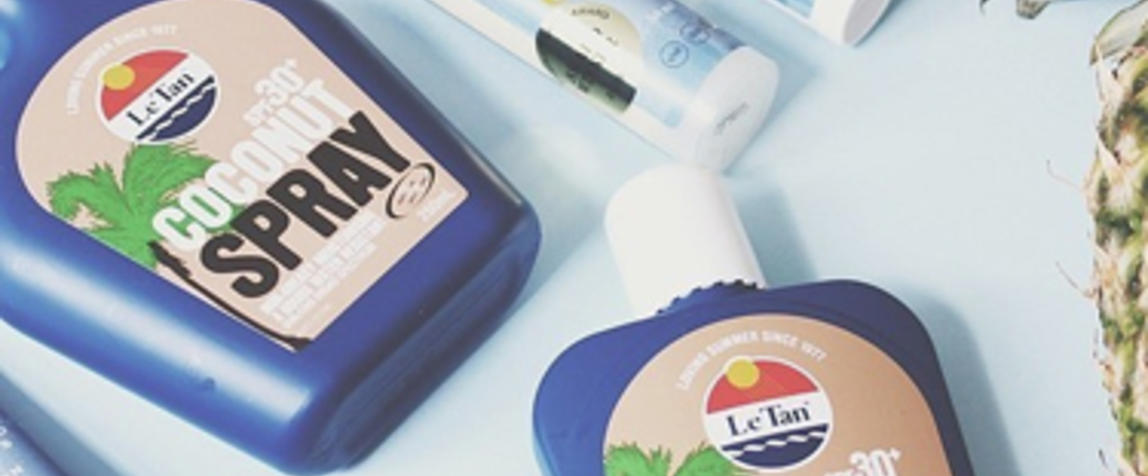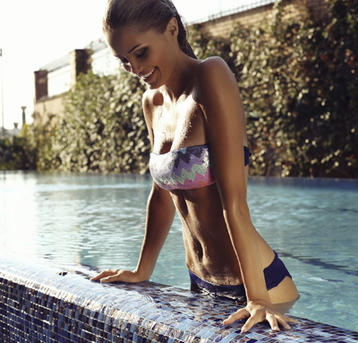Australians are no strangers to sunscreen. The sun-protection mantra ‘slip, slop, slap’ is drummed into us from an early age. But, thanks to technological advancements and consumer demands creating increasingly elaborate and ingenious inventions in the arena, the field of sun protection can be confusing. Below, BD reveals everything you need to know about the beauty essential, from its different types to where it will be heading next year.
What is the difference between physical and chemical sunscreen?
Summarises dermatologist and expert Saxon Donald Smith: “Sunscreens made of chemicals which absorb UV rays convert this absorbed energy into safer longer lower energy wavelengths such as infra-red which is felt as heat only in the skin. Generally, UVA rays are absorbed by different chemicals (e.g. avobenzone) to those which absorb UVB rays (e.g. octinoxate). These chemicals are absorbed into the very top layer of the skin (epidermis) and protect against UV rays penetrating deeper in the skin (dermis). On the other hand, physical blockers (e.g. titanium dioxide and zinc oxide) simply but effectively reflect or scatter the UVR from the skin surface. These particles sit on top of the skin (epidermis) and protect against further penetration deeper into the skin (dermis).”
What is more common in Australia?
Smith continues, “Physical and chemical sunscreens are both part of the range of sunscreens in Australia. Chemical ingredients are commonly used across major sunscreen brands and approved by the TGA (Therapeutic Goods Authority) just as physical sunscreens are. Sunscreens, physical and chemical, with an SPF over 15 are tested to the Australian Standard (highest testing standard in the world for sunscreens) and are controlled by the TGA as a medical product. So as long as you use an Australian sunscreen, it doesn’t matter if it uses just physical blockers, just chemical blockers, or a mixture of both.”
Is one more effective than the other?
In short, no – it comes down to preference. Says education manager Emma Hobson: “One is not better than the other in performance, but physical sunscreens are recommended for those with more sensitive skin as they seem to tolerate the physical UV screening agents over the chemical ones. Personal taste plays a factor too especially when exercising. Some people don’t like the feeling of a physical sunscreen ‘sitting’ on the skin surface, especially when they sweat, also the feeling of a slight ‘chalkiness’ that physical sunscreens can have, even though the texture of physical sunscreens has come an enormous way since they were first produced.”
Smith agrees, commenting: “Both chemical absorbers and physical blockers are equally effective at protecting the skin when applied appropriately. In addition, both use TGA-approved ingredients. Choosing a sunscreen, like choosing moisturisers or even shoes, is a very personal thing as people like different characteristics in the creams that they use. Some people like lighter lotion-based sunscreens, whereas others like the thicker sport-focused sunscreens.”
What are the other key misconceptions surrounding sunscreen?
Says Hobson: “Some people who have a darker skin tone believe because they don’t ‘burn’ in the sun they don’t need protection, which is of course not true. Everyone benefits from wearing a sunscreen to protect the skin regardless of the depth of skin colour. Some people who don’t sunbathe think they don’t need to apply a product because they are hardly in the sun, this is also a fallacy, unless you never go outdoors in the day time!” There is also the belief that sunscreen causes breakouts. Confirms Smith: “Most modern sunscreens are generally designed not to clog your skin’s pores which can cause acne.” Continues Oriana Morales of Invisible Zinc that most commonly she finds: "some consumers mistakenly believe that if the sun is not out they don’t need the protection, or if they are not going to the beach there’s no need for sunscreen. Reality is, even in outcast days the UV rays penetrate through and cause damage to the skin, even if it is not visibly burnt!"
What do consumers look for in sunscreen?
marketing manager Michelle Stephens explains of the brand’s research: “Our research shows that the top considerations for consumers when choosing a sunscreen are: lasting protection, a formula which is non greasy/sticky, [a formula that] won't come off when sweating, a format that [they] like (lotion cream, spray, gel), [and a formula that is] water-resistant.” Hydration is also a key concern to consumers, explains scientist Ken Lee: “We recently conducted research into the attitudes and behaviours of Australian women in relation to their suncare regimen, which has confirmed that dry and dehydrated skin is the top sun-related skin concern and so is highly relevant in optimising sun protection products. So when considering this, it’s natural to expect that one of the biggest innovations for the suncare space is the inclusion of moisturising ingredients, which is exactly what NIVEA has done with their Protect and Moisture Sunscreen Lotions range. In particular, our combination of panthenol, glycerin and vitamin E helps keep the skin hydrated for up to 24 hours and therefore making it less vulnerable to sun damage.”
What is the correct application of sunscreen?
Half a teaspoon on each limb is the recommended amount of sunscreen. Says Hobson, this is a key arena in which many consumers fall short. “Don’t rely on your makeup SPF to give you sufficient protection, unless you were going to apply massive amounts of the product. The CCA recommends you apply a half teaspoon of sunscreen for the face, neck and ears, that would be a heck of a lot of foundation or powder!” Continues Lee: “Regardless of the SPF level you use, it is generally recommended to reapply suncare products at least every two hours to maintain the sun protection level. This is particularly important after swimming and towel-drying, where the protection period is shortened as the sunscreen film can be partially removed. It is important to note that multiple other factors can also affect your level of protection, such as how much sunscreen you apply, the weather, amount of sweating, swimming, as well as your own skin type.”
Agrees Smith: “This includes applying it 20 minutes before going outside; reapplying every two hours or after swimming or sweating; and make sure you apply enough sunscreen by applying about 35-40ml for whole body of an average adult (about the size of a golf ball). It is also important to check the expiry date on your sunscreen and ensure you store it below 30°C because expired or heat-affected sunscreen may not be as effective.”
Says founder Sinead Roberts: Whether you use a sunscreen with a chemical UV filter or a physical blocker, sunscreen needs to be applied 20 mins before exposure to the sun." She believes women in particular need to take heed of this:"This is particularly important if you are using sunscreen under makeup to ensure that it is not rubbed off when you apply your foundation."
What innovations can we expect from 2017?
First things first, application remains of key importance to consumers and is the reason that packaging remains of interest. Aerosol sprays, spray bottles and oils have taken centre stage in the sunscreen world, with Stephens confirming: “Packaging innovation is a key area where we have seen most of the innovations over the years and will continue to be the main area of innovation for brands.” As to what this means specifically, Morales comments sprays and aerosols aren't going anywhere: "For 2016/17 season we’re seeing more aerosol sprays and lightweight formulas as well as family size pumps that can be used for the entire family."
But ingredient innovations continue to change day by day. As to what will be next in sunscreen formulations, Hobson predicts that antioxidants (particularly vitamins A and E) will see popularity. “There is a growing body of research showing that topically applied antioxidants can help protect from sun damage. Although antioxidants don't replace the need to use sunscreens, when used in combination with them, they are highly effective and a wonderful addition to the protective value of a well-formulated sunscreen. Vitamins (especially E and C) have been the topic of several studies on the photo-protective effects of antioxidants when combined with sunscreens. Additionally, antioxidants in sunscreens help enhance the stability of the active ingredients, allowing them to work as they should for a longer period of time.”
As to what else, Hobson believes that brands will be drawn to slightly unusual extracts. “Including grape seed and green tea within a sunscreen product has been found to be extremely effective at scavenging UV-induced free radicals thus adding extra protection for the skin,” she says.
Does sunscreen prevent the body from receiving adequate levels of vitamin D?
Explains Hobson, this is a common misconception: “Some people think if they wear a sunscreen they won’t get sufficient vitamin D synthesis. The Australian climate as it is, if you go outdoors you will generally receive sufficient UV exposure to produce your vitamin D while wearing a sunscreen.” There are now also continuing innovations – such as the Solar D sunscreen – that encourages adequate vitamin D exposure without putting the skin at risk. Says Solar D brand expert Anne-Marie Zukerman: “We are the only ones in the world that have developed a sunscreen that lets in some of the light that our bodies use to make vitamin D. We believe that with the growing epidemic of vitamin D deficiency and the many illnesses associated with the deficiency, that Solar D sunscreen will be a trendsetter for 2017 and beyond. Our message is that people can have their cake and eat it [too]. They can get sun protection plus get their dose of vitamin D.”
Image: @letansummer




